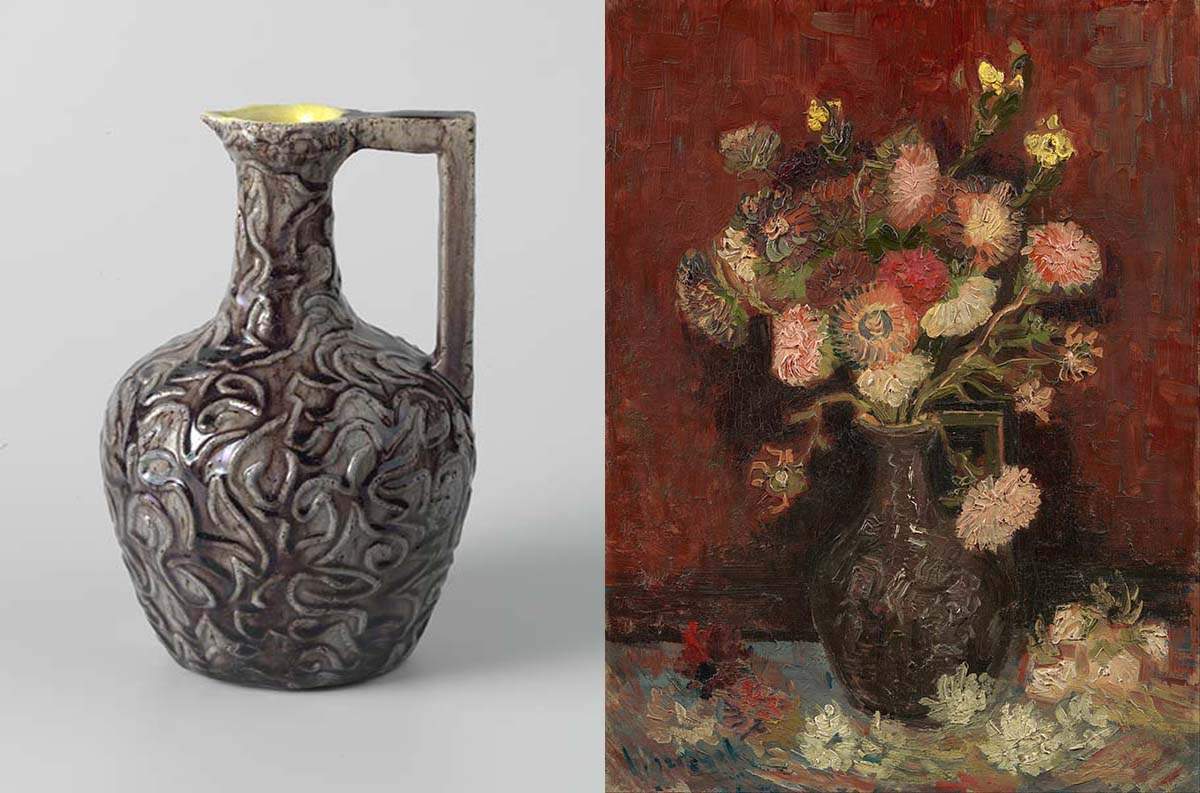At the Van Gogh House in Zundert an exhibition with objects from Van Gogh's paintings
From July 30 to Oct. 30, 2022, the Vincent van Gogh House in Zundert in the Netherlands presents the exhibition Closer to Vincent - Everyday Objects in the Work of Vincent van Gogh, based on new research by art historian Alexandra van Dongen on the objects Van Gogh depicted in his paintings, for a study that has provided many new insights into Van Gogh’s work. The exhibition, designed by artists André Smits & Monika Dahlberg, contains various everyday objects, of those the artist often painted in his works, from the beginning of his career until the last year of his life in France.
They can be found in his early works in his interiors with people engaged in housework or figures sitting on chairs by the fireplace, and later objects are also found in his still lifes and floral paintings, which he regarded primarily as studies of color and form. Often these paintings arose because of the chronic lack of money that prevented Van Gogh from being able to afford living models. Some of these everyday objects used by Vincent, for example a flower vase, a French earthenware liquor jug, and a Norman copper milk jug, ended up in the collection of the Van Gogh Museum in Amsterdam thanks to Vincent’s sister-in-law, Jo van Gogh-Bonger.
Never before had all the everyday objects depicted by Vincent been accurately identified. However, recent research by art historian Alexandra van Dongen, curator of historical design at the Museum Boijmans Van Beuningen in Rotterdam, has shown that precise identification of Vincent’s objects can sometimes shed new light on the possible place of production and dating of his work. For example, a very simple earthenware casserole that appears in Still Life with Potatoes comes from Vallauris, an important center of ceramic production in southern France. Vincent was previously thought to have painted this still life in Nuenen, but identification of the casserole and technical research on the canvas show that the painting was made in Paris in 1886.
Before leaving for France, Vincent began a series of still lifes in Nuenen in his studio behind his parents’ house. The utensils depicted give a good idea of the Brabant and other kitchen utensils of the time. The presence of such objects in Vincent’s mother’s kitchen has been confirmed by recent archaeological findings in the rectory courtyard. Vincent sometimes borrowed antique or special objects from collector and amateur painter Antoon Hermans, to whom he gave painting lessons. The sketches for The Potato Eaters clearly show what objects Vincent had chosen and studied for his composition. For the exhibition, the Netherlands Open Air Museum is providing a similar specimen of the distinctive kerosene lamp that hangs above the table, just as in the interiors of the Nuenen Weavers. Wooden chairs are also often used in Vincent’s work. They are also the main subject of two paintings that he considered portraits of Gauguin and himself when they worked briefly together at the Yellow House in Arles. Many of his famous French floral still lifes show “vases” that were not originally intended as flower vases. In fact, Vincent placed his bouquets inside stoneware beer mugs, majolica pitchers and apothecary jars, copper milk jugs, and terracotta pots intended for storing confit de canard. The presence of certain types of objects in Vincent’s work often says something about where and where he painted them or refers to his sources of artistic inspiration. Because Vincent portrayed his material models in a very naturalistic way, they are often very easy to identify. Alexandra van Dongen focuses the gaze on small details, on objects that we do not usually pay attention to, but which are very significant for understanding Van Gogh’s work even better.
The exhibition in the House of Vincent van Gogh takes place on the occasion of the publication of Alexandra van Dongen’s research at Uitgeverij Sterck & De Vreese types. In early 2021, Van Dongen spent a month at the sexton’s house in Zundert as an “artist-in-residence” to continue her research and has already presented some of her findings on Brabant objects in Van Gogh’s work in the small exhibition You can’t get any closer, which had at its center archaeological finds from the courtyard of the Nuenen rectory, with which it became clear what objects Vincent translated into paint at the time he worked behind his parents’ house. Together with visual artists André Smits (Artist in the World) and Monika Dahlberg, who will hold an artist residency in Zundert between July and August 2022, Van Dongen is translating his research into an exhibition with texts, drawings and collages on the walls and a selection of objects, which make visible the paintings and places where Van Gogh worked. Central to the exhibition are objects from Vincent van Gogh’s estate, which are on loan from the Van Gogh Museum in Amsterdam and the Musée d’Orsay in Paris. Archaeological artifacts from the Nuenen rectory garden are also on display. In addition, the public can see a confit de canard vase of the same type as those Van Gogh used in his still lifes with sunflowers, and a replica of the willow chair that Vincent painted in Arles and on which his models, such as the letter carrier Joseph Roulin, posed. This replica was made especially for the exhibition in the Van Gogh Huouse by chair manufacturer Rien Stuijts.
For all information you can visit the Van Gogh House website.
 |
| At the Van Gogh House in Zundert an exhibition with objects from Van Gogh's paintings |
Warning: the translation into English of the original Italian article was created using automatic tools. We undertake to review all articles, but we do not guarantee the total absence of inaccuracies in the translation due to the program. You can find the original by clicking on the ITA button. If you find any mistake,please contact us.





























